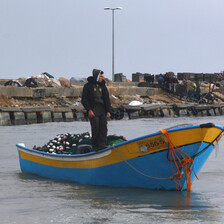The Electronic Intifada 16 July 2009
GAZA CITY, occupied Gaza Strip (IPS) - “No one is buying meat these days,” says Yousef al-Jerjowi, sitting next to his butcher shop devoid of customers.
“There are some people who buy frozen meat, because it’s much cheaper: 20 shekels ($5) per kilo versus 60 shekels for fresh beef.”
According to the 45-year-old father of ten, while business is in general terrible, the better days are early in the month, when those with salaried jobs often receive their pay.
“On average, I might make 200 shekels a day in the first five days of the new month. Before the siege, it was 450 shekels a day. I do have some more regular customers. But they have no money. They keep a tab, and pay when they can.”
Like many Palestinians, al-Jerjowi used to work in Israel. “When Israel closed the borders, I had no work. So I opened a butcher shop.”
On a normal day, al-Jerjowi says he only earns at best 100 shekels, not enough to cover the rent of his shop — $4,000 a year — nor that of his family’s homes. “My three sons are all married. Together, our house rents are 200 shekels per month. We’re not earning that money. And there are daily expenses, like electricity and water.”
With unemployment rates at 50 percent in Gaza, and 80 percent of Gazan Palestinians dependent on food aid hand-outs, it’s no wonder that al-Jerjowi’s business isn’t booming.
But the problem lies not only with Gaza’s siege-shattered economy and the great poverty this has created; it is also the scarcity of beef.
After the three weeks of the Israeli air, land and sea bombardment which killed over 1,400 people, Gaza’s agricultural sector is devastated, and that includes the beef farmers. The United Nations Development Project reports that 17 percent of Gaza’s livestock and nearly ten percent of the poultry were killed during the war. And even before the Israeli attacks, in November 2008 Gaza’s Ministry of Agriculture was already warning of a “real food disaster” due to the siege on animal feed and livestock, directly affecting the well-being of what livestock did exist in Gaza.
Gazan Palestinians have tried to make up for the deficit of cattle by bringing calves and sheep through the tunnels from Egypt. Yet, the prices are high, above the budgets of most.
On 19 June, for the first time since 31 October 2008, Israel allowed livestock into Gaza: 15 trucks. This number falls far below not only the nutritional needs of Gaza’s residents, but also the capacity of the border crossing to receive trucks.
In 2008 and 2007, according to the Office for Coordination of Humanitarian Affairs (OCHA) the monthly total of livestock trucks entering Gaza varied from 20 to 207, keeping with the trend of severely restricting Gaza’s livestock imports under the Israeli-led siege.
Prior to 19 June, the only cattle shipment overland into Gaza was on 31 October 2008, with a monthly total 78 trucks — to last nearly nine months. The Coordinator of the Israeli Government Activities in the Territories (COGAT) previously suggested an amount of 300 cows weekly as the minimum for the nutrition of Gaza’s 1.5 million people.
According to the UN and various non-governmental organizations (NGOs), the trickle of goods entering Gaza now is just a quarter of that prior to the siege, the majority of which is limited to basic food aid items. The aid-dependent families have moved from a balanced diet to one consisting mainly of sugar and carbohydrates, lacking in vitamins and proteins.
The World Health Organization (WHO) cites an increase in growth-stunting malnourishment, now at over 10 percent of children, attributed to a chronic lack of protein, iron, and essential vitamins. The WHO further warns of increasing anemia rates: 65 percent among children below 12 months of age, and 35 percent among pregnant women.
The United Nations Children’s Agency (UNICEF), the World Health Organization (WHO), and Gaza’s Ard al-Insan center for nutrition, among various bodies, note the link between malnutrition and a deficiency of protein and vegetables in the diet.
An International Committee of the Red Cross (ICRC) June 2009 report notes that the effects of a restricted diet also include “difficulty in fighting off infections, fatigue and a reduced capacity to learn.” The ICRC warns of the long-term ramifications on Gaza’s malnourished children.
In June 2009, 38 NGOs, including Oxfam, Care World Vision, and UN bodies, called for an end to the siege, citing the need for normalized trade with Gaza. The ICRC June report likewise called for resumption of imports and exports, but warned that the situation has deteriorated to an extent that Gaza will need years to recover.
For Yousef al-Jerjowi, who has scaled down his opening hours due to the lack of customers, the siege couldn’t end soon enough. Jerjowi’s three sons work in his shop, saving him 40 shekels daily wages for an employee. “If my sons didn’t work here, I’d have to close the shop.”
All rights reserved, IPS — Inter Press Service (2009). Total or partial publication, retransmission or sale forbidden.





